National Drop Everything and Read (D.E.A.R.) Day is celebrated annually on Beverly Cleary’s birthday, April 12. Teachers, librarians, and parents can find resources related to D.E.A.R. to encourage everyone to put other things aside everything and take time to read every day. The recently published fiction and nonfiction books reviewed in this column invite readers to explore engaging stories and information that will spark discussion and further inquiry.
Ages 4–8
Life on Mars. Jon Agee. 2017. Dial/Penguin.
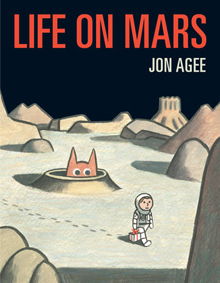 This humorous book will keep young readers guessing as they consider both the words and the images. The story starts on the front endpaper, which shows a ship rocketing to Mars. On the following page readers meet the young boy who has just landed; he carries a box with a red ribbon around it and is searching for life. The boy tells us exactly what he is thinking and doing (“I can’t believe it. I’m lost!”). The text is simple, sparse, and straightforward. However, based only on the text, readers would only learn part of the story. The real action takes place in the art. Agee’s cartoon-style illustrations not only add to the humor but also advance the plot in a way young readers will find engaging and satisfying. Life on Mars isthe kind of picture book that begs to be read again and again.
This humorous book will keep young readers guessing as they consider both the words and the images. The story starts on the front endpaper, which shows a ship rocketing to Mars. On the following page readers meet the young boy who has just landed; he carries a box with a red ribbon around it and is searching for life. The boy tells us exactly what he is thinking and doing (“I can’t believe it. I’m lost!”). The text is simple, sparse, and straightforward. However, based only on the text, readers would only learn part of the story. The real action takes place in the art. Agee’s cartoon-style illustrations not only add to the humor but also advance the plot in a way young readers will find engaging and satisfying. Life on Mars isthe kind of picture book that begs to be read again and again.
—LC
My Awesome Summer by P. Mantis. Paul Meisel. 2017. Holiday House.
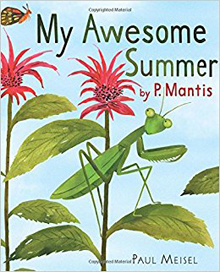 Did you know that the adult praying mantis can eat almost anything it finds or that it uses camouflage to hide from predators? In this cleverly designed book, P. Mantis takes readers on a journey through her life cycle. Written in a first-person diary format (“May 17: I was born today!”) with embedded facts about the praying mantis’ habitat, food preferences, protective instincts, and life cycle coupled with colorful acrylic paintings, this is an engaging and informative book. Meisel’s illustrations extend the text and add humor while inviting readers to search for P. Mantis, who is hidden among the leaves and branches in her habitat. Front and back matter include facts, diagrams, a glossary, and websites for more information about this fascinating insect.
Did you know that the adult praying mantis can eat almost anything it finds or that it uses camouflage to hide from predators? In this cleverly designed book, P. Mantis takes readers on a journey through her life cycle. Written in a first-person diary format (“May 17: I was born today!”) with embedded facts about the praying mantis’ habitat, food preferences, protective instincts, and life cycle coupled with colorful acrylic paintings, this is an engaging and informative book. Meisel’s illustrations extend the text and add humor while inviting readers to search for P. Mantis, who is hidden among the leaves and branches in her habitat. Front and back matter include facts, diagrams, a glossary, and websites for more information about this fascinating insect.
—MN
Ages 9–11
The Banana-Leaf Ball: How Play Can Change the World (CitizenKid). Katie Smith Milway. Ill. Shane Evans. 2017. Kids Can.
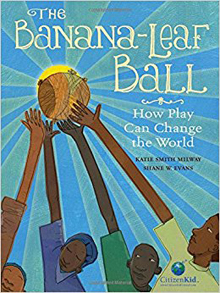 Young Deo Rukundo and his family flee from war in Burundi, in East Africa. Displaced from his family, Deo finds his way to a refugee camp in Tanzania, where he keeps to himself, worries about his family, and reminiscences about playing soccer with his friends with balls made from banana leaves. When a coach from the Right to Play organization visits the camp and organizes a soccer game using a leather ball, Deo and Remy (a playground bully) end up on the same team. Deo’s natural soccer ability and sportsmanship shine on the field. When Deo passes the ball to Remy to score the winning goal for their team, they build a new understanding and respect for each other. Soon, Deo is teaching Remy and other boys how to make banana-leaf balls. The universal message of patience, tolerance, respect, and kindness will inspire readers. Shane Evans’ expressive paintings add depth and richness to the powerful and emotional narrative. The author’s note includes information about Benjamin Nzobonankira, the inspiration for the story. Benjamin, a former child refugee, now trains Right to Play coaches, who support youth, foster confidence, and build understanding and empathy through teamwork. The back matter contains photographs and resources about Right to Play and other organizations with the mission of teaching kids to trust and include others through play.
Young Deo Rukundo and his family flee from war in Burundi, in East Africa. Displaced from his family, Deo finds his way to a refugee camp in Tanzania, where he keeps to himself, worries about his family, and reminiscences about playing soccer with his friends with balls made from banana leaves. When a coach from the Right to Play organization visits the camp and organizes a soccer game using a leather ball, Deo and Remy (a playground bully) end up on the same team. Deo’s natural soccer ability and sportsmanship shine on the field. When Deo passes the ball to Remy to score the winning goal for their team, they build a new understanding and respect for each other. Soon, Deo is teaching Remy and other boys how to make banana-leaf balls. The universal message of patience, tolerance, respect, and kindness will inspire readers. Shane Evans’ expressive paintings add depth and richness to the powerful and emotional narrative. The author’s note includes information about Benjamin Nzobonankira, the inspiration for the story. Benjamin, a former child refugee, now trains Right to Play coaches, who support youth, foster confidence, and build understanding and empathy through teamwork. The back matter contains photographs and resources about Right to Play and other organizations with the mission of teaching kids to trust and include others through play.
—MN
Grand Canyon. Jason Chin. 2017. Roaring Brook/Macmillan.
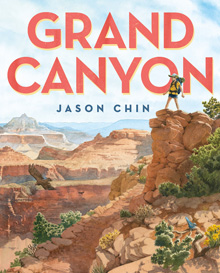 The lush watercolor illustrations will attract readers to this informational text about the geology and ecology of the Grand Canyon. Narrative elements combine with a variety of visual and textual features to make for an engaging read. The pictures tell a story of a father and daughter on a hike through the canyon while the text describes its geological features. Double-page spreads showing the young hiker in scenes millions of years ago alternate with pages on which scientific information is provided in sidebars. Using die cuts and sentences ending in ellipses, the art and the text encourage the reader to turn the pages. The story ends with a dramatic gatefold that captures a panoramic view of the canyon and the two explorers. Curious readers will find a wealth of additional information about the Grand Canyon, sources (books, websites, and articles), and a list of suggested reading in the back matter.
The lush watercolor illustrations will attract readers to this informational text about the geology and ecology of the Grand Canyon. Narrative elements combine with a variety of visual and textual features to make for an engaging read. The pictures tell a story of a father and daughter on a hike through the canyon while the text describes its geological features. Double-page spreads showing the young hiker in scenes millions of years ago alternate with pages on which scientific information is provided in sidebars. Using die cuts and sentences ending in ellipses, the art and the text encourage the reader to turn the pages. The story ends with a dramatic gatefold that captures a panoramic view of the canyon and the two explorers. Curious readers will find a wealth of additional information about the Grand Canyon, sources (books, websites, and articles), and a list of suggested reading in the back matter.
—LC
Ages 12–14
Motor Girls: How Women Took the Wheel and Drove Boldly into the Twentieth Century. Sue Macy. 2017. National Geographic.
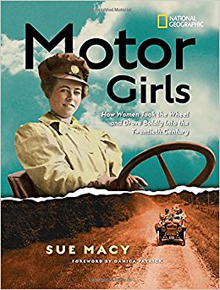 Organized in five well-written and informative chapters, Sue Macy’s latest nonfiction selection chronicles the history of the automobile and the intricate paths, situated across politics and gender expectations, that opened opportunities for women of the early twentieth century to drive motor vehicles. Alice Ramsey, the first woman to drive a car across the United States, and other “Motor Girls” who revved up women’s place behind the wheel are featured. Glossy photographs, sidebar features, archival clippings, and period advertisements grace the pages. Macy masterfully weaves research and her unique writing style to inform readers of the significant contributions of women throughout history. Detailed back matter includes resources and an epilogue.
Organized in five well-written and informative chapters, Sue Macy’s latest nonfiction selection chronicles the history of the automobile and the intricate paths, situated across politics and gender expectations, that opened opportunities for women of the early twentieth century to drive motor vehicles. Alice Ramsey, the first woman to drive a car across the United States, and other “Motor Girls” who revved up women’s place behind the wheel are featured. Glossy photographs, sidebar features, archival clippings, and period advertisements grace the pages. Macy masterfully weaves research and her unique writing style to inform readers of the significant contributions of women throughout history. Detailed back matter includes resources and an epilogue.
—MN
Short. Holly Goldberg Sloan. 2017. Dial/Penguin.
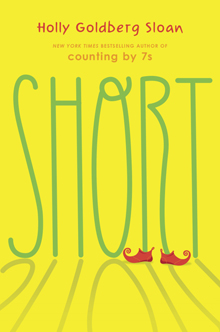 Julia Marks is short—very short—and it gets in her way until one summer when she reluctantly tries out for and gets cast as a munchkin in a community play. She makes some unlikely friends among members of the cast and crew in addition to her quirky and creative elderly neighbor, Mrs. Chang. Julia works her way through the pre-adolescent angst of her dog’s death, coming to terms with her height, and figuring out what’s important in life with wit and heart. She is a likable character, who will appeal to a variety of readers, and the story has enough complexity and action to hold readers’ attention.
Julia Marks is short—very short—and it gets in her way until one summer when she reluctantly tries out for and gets cast as a munchkin in a community play. She makes some unlikely friends among members of the cast and crew in addition to her quirky and creative elderly neighbor, Mrs. Chang. Julia works her way through the pre-adolescent angst of her dog’s death, coming to terms with her height, and figuring out what’s important in life with wit and heart. She is a likable character, who will appeal to a variety of readers, and the story has enough complexity and action to hold readers’ attention.
—HO
Ages 15+
American Street. Ibi Zoboi. 2017. Balzer + Bray/HarperCollins.
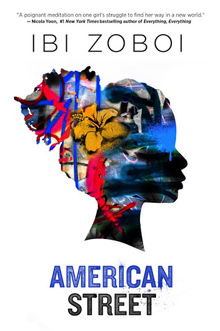 Fabiola finds herself in Detroit on her own after her mother is detained as they enter the country from Haiti. Living with her three cousins and their mother, Fabiola begins to navigate life in the United States without letting go of her connections to Haiti, her spiritual life, or her mother. She makes friends, faces dangers within her new community, and is forced to make a difficult decision that might help her mother. American Street provides a glimpse into the immigrant struggle, as well as the urban landscape, with honesty and authenticity. Readers may recognize typical school and peer experiences in the story but will also be exposed to specific aspects of Haitian culture from an insider’s perspective.
Fabiola finds herself in Detroit on her own after her mother is detained as they enter the country from Haiti. Living with her three cousins and their mother, Fabiola begins to navigate life in the United States without letting go of her connections to Haiti, her spiritual life, or her mother. She makes friends, faces dangers within her new community, and is forced to make a difficult decision that might help her mother. American Street provides a glimpse into the immigrant struggle, as well as the urban landscape, with honesty and authenticity. Readers may recognize typical school and peer experiences in the story but will also be exposed to specific aspects of Haitian culture from an insider’s perspective.
—LC
The March Against Fear: The Last Great Walk of the Civil Rights Movement and the Emergence of Black Power. AnnBausum. 2017. National Geographic.
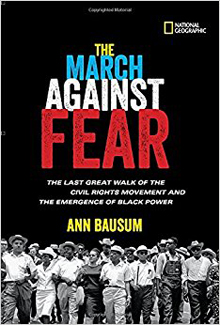 When thinking of the Civil Rights Movement, there are people and events that immediately come to mind. The March Against Fear, a well-researched exploration of the 1966 march across Mississippi, is one of these. The march was the brainchild of James Meredith, but was organized and led by civil rights giants Martin Luther King, Jr., Stokely Carmichael, and Floyd McKissick after Meredith was shot at the beginning of the march. Captioned archival photographs and quotes throughout the text paired with vivid, unflinching descriptions of the sometimes almost unbelievable injustices and humiliations visited upon the marchers make the tension, fear, and determination they accessible to the reader. This book offers another avenue to enter the timeline of the Civil Rights Movement and highlights some lesser-known activists. Back matter includes an author’s note, source notes, a bibliography, and index.
When thinking of the Civil Rights Movement, there are people and events that immediately come to mind. The March Against Fear, a well-researched exploration of the 1966 march across Mississippi, is one of these. The march was the brainchild of James Meredith, but was organized and led by civil rights giants Martin Luther King, Jr., Stokely Carmichael, and Floyd McKissick after Meredith was shot at the beginning of the march. Captioned archival photographs and quotes throughout the text paired with vivid, unflinching descriptions of the sometimes almost unbelievable injustices and humiliations visited upon the marchers make the tension, fear, and determination they accessible to the reader. This book offers another avenue to enter the timeline of the Civil Rights Movement and highlights some lesser-known activists. Back matter includes an author’s note, source notes, a bibliography, and index.
—HO
Author Jason Chin will be at ILA 2017 Conference & Exhibits as part of the Primary Author Meetup, which takes place Saturday, July 15, from 3:00 p.m. to 5:00 p.m.
Lesley Colabucci is an associate professor of early, middle, and exceptional education at Millersville University. She teaches classes in children’s literature at the graduate and undergraduate level. Her research interests include multicultural children’s literature and response to literature. Mary Napoli is an associate professor of Reading and Children’s Literature at Penn State Harrisburg, where she teaches both undergraduate and graduate literacy courses. Hannah Oberg is a graduate student in the literacy education program at Penn State Harrisburg and a secondary English teacher.
These reviews are submitted by members of the International Literacy Association's Children's Literature and Reading Special Interest Group (CL/R SIG) and are published weekly on Literacy Daily.